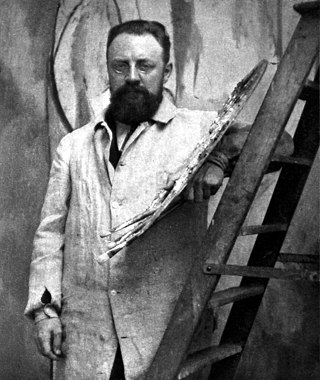
Henri Émile Benoît Matisse was a French visual artist, known for both his use of colour and his fluid and original draughtsmanship. He was a draughtsman, printmaker, and sculptor, but is known primarily as a painter. Matisse is commonly regarded, along with Pablo Picasso, as one of the artists who best helped to define the revolutionary developments in the visual arts throughout the opening decades of the twentieth century, responsible for significant developments in painting and sculpture.

André Derain was a French artist, painter, sculptor and co-founder of Fauvism with Henri Matisse.
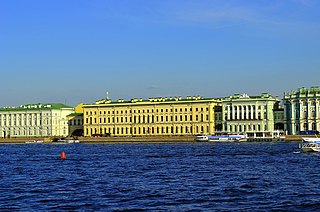
The State Hermitage Museum is a museum of art and culture in Saint Petersburg, Russia. It was founded in 1764 when Empress Catherine the Great acquired a collection of paintings from the Berlin merchant Johann Ernst Gotzkowsky. The museum celebrates the anniversary of its founding each year on 7 December, Saint Catherine's Day. It has been open to the public since 1852. The Art Newspaper ranked the museum 10th in their list of the most visited art museums, with 2,812,913 visitors in 2022.

Henri-Edmond Cross, born Henri-Edmond-Joseph Delacroix, was a French painter and printmaker. He is most acclaimed as a master of Neo-Impressionism and he played an important role in shaping the second phase of that movement. He was a significant influence on Henri Matisse and many other artists. His work was instrumental in the development of Fauvism.

Dance (La Danse) is a painting made by Henri Matisse in 1910, at the request of Russian businessman and art collector Sergei Shchukin, who bequeathed the large decorative panel to the Hermitage Museum, in Saint Petersburg. The composition of dancing figures is commonly recognized as "a key point of (Matisse's) career and in the development of modern painting". A preliminary version of the work, sketched by Matisse in 1909 as a study for the work, resides at MoMA in New York, where it has been labeled Dance (I).

The Conversation, a painting by Henri Matisse dating from 1908 to 1912, depicts the artist and his wife facing each other before a background of intense blue. It is in the collection of the Hermitage Museum in Saint Petersburg, Russia.
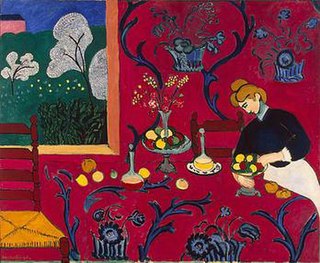
The Dessert: Harmony in Red is a painting by French artist Henri Matisse, from 1908. It is considered by some critics to be Matisse's masterpiece. This Fauvist painting follows the example set by Impressionism with the overall lack of a central focal point.

Le bonheur de vivre is a painting by Henri Matisse. Along with Picasso's Les Demoiselles d'Avignon, Le bonheur de vivre is regarded as one of the pillars of early modernism. The monumental canvas was first exhibited at the Salon des Indépendants of 1906, where its cadmium colors and spatial distortions caused a public expression of protest and outrage.
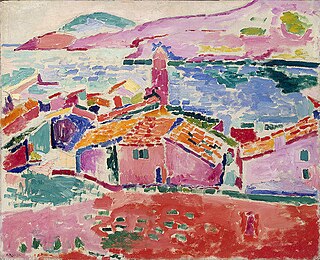
View of Collioure is a 1905 oil-on-canvas painting by Henri Matisse. It is an example of the style that Matisse employed during his early period of Fauvism. The painting has been in the collection of The Hermitage, St. Petersburg, Russia since 1948. It was originally part of the Sergei Shchukin collection, and then was at the State Museum of New Western Art in Moscow.
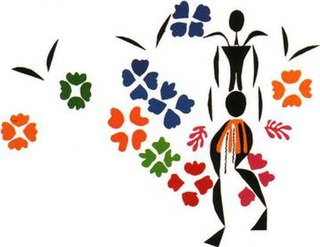
La Négresse (1952–53) by Henri Matisse is a gouache découpée, made of cut pieces of colored paper.

Window at Tangier; also referred to as La Fenêtre à Tanger, Paysage vu d'une fenêtre, and Landscape viewed from a window, Tangiers, is a painting by Henri Matisse, executed in 1912. It is held at the Pushkin Museum of Fine Arts, Moscow.

Henri Victor Gabriel Le Fauconnier was a French Cubist painter born in Hesdin. Le Fauconnier was seen as one of the leading figures among the Montparnasse Cubists. At the 1911 Salon des Indépendants Le Fauconnier and colleagues Jean Metzinger, Albert Gleizes, Fernand Léger and Robert Delaunay caused a scandal with their Cubist paintings. He was in contacts with many European avant-garde artists such as Wassily Kandinsky, writing a theoretical text for the catalogue of the Neue Künstlervereinigung in Munich, of which he became a member. His paintings were exhibited in Moscow reproduced as examples of the latest art in Der Blaue Reiter Almanach.

Fauvism is a style of painting and an art movement that emerged in France at the beginning of the 20th century. It was the style of les Fauves, a group of modern artists whose works emphasized painterly qualities and strong colour over the representational or realistic values retained by Impressionism. While Fauvism as a style began around 1904 and continued beyond 1910, the movement as such lasted only a few years, 1905–1908, and had three exhibitions. The leaders of the movement were André Derain and Henri Matisse.
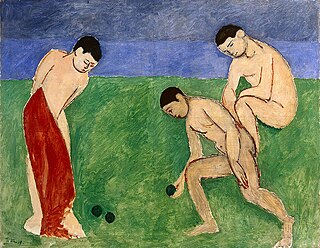
Game of Bowls is a 1908 painting by the French artist Henri Matisse. The painting shows three young men, probably Matisse's sons and nephew, playing a game of boules. Matisse sees the game as a manifestation of man's creativity, and an instrument to use in understanding the codes of life. The painting is part of Matisse's series on man's "Golden Age" and was part of Sergei Shchukin's collection before the October Revolution of 1917. It is now in the collection of The Hermitage, St. Petersburg, Russia.

Sergei Ivanovich Shchukin was a Russian businessman who became an art collector, mainly of French Impressionist and Post-Impressionist art.
Lydia Nikolaevna Délectorskaya was a Russian refugee and model best known for her collaboration with Henri Matisse from 1932 onwards.

Casting the Net is an oil-on-canvas painting by French artist Suzanne Valadon, executed in 1914. It has the dimensions of 201 by 301 cm. It is held in the collection of the Museum of Fine Arts in Nancy.
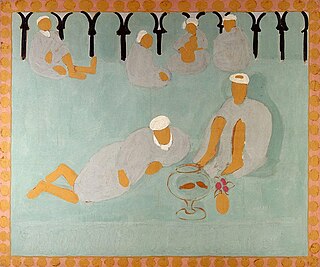
Arab Coffeehouse, is an oil-on-canvas painting by French visual artist Henri Matisse. Produced in 1913, Arab Coffeehouse was part of a series of goldfish paintings that Matisse produced in the 1910s and 1920s.

















